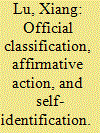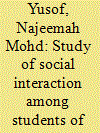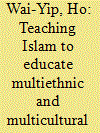| Srl | Item |
| 1 |
ID:
184075


|
|
|
|
|
| Summary/Abstract |
The existing literature on the self-identity of multiethnic people focuses on Western countries where mixed identities have been normalised in census-taking. It remains unknown how multiethnic people identify themselves in countries where ethnic classification is exclusive and rigid and ethnicity is a mainly ascriptive legal category. Based on in-depth interviews with twenty Hui-Han biethnic college students in China, this article shows how official ethnic classification and affirmative action shape these people’s self-identification. Most respondents identify themselves as Hui regardless of their cultural practices, as their parents registered their official ethnicity as Hui and they have internalised this identity. The multiethnic background is more frustrating for students at China’s special ‘universities for ethnicities’ because ethnicity is a salient topic on campus and they experience more expectations to behave like Hui. Many respondents have an essentialist understanding of ethnicity and express unsupportive attitudes towards institutionalising mixed identities.
|
|
|
|
|
|
|
|
|
|
|
|
|
|
|
|
| 2 |
ID:
109852


|
|
|
|
|
| Publication |
2012.
|
| Summary/Abstract |
The purpose of this study is to examine the social interaction among students of various ethnic groups at Vision Schools in Malaysia. The focus is mainly on Malays, Chinese and Indians with a sample size of 642 students. This research applies the quantitative and qualitative approach. For the qualitative approach, the researcher used focus group interviews and observations to examine social interaction among students of various ethnic groups. In this research there is one independent variable to explain and predict eleven independent variables. Hypotheses were analysed using post-hoc and multivariate analysis at a p < 0.05 significance level. Findings of the study indicated there were significant difference in the mean score levels for all the independent variables. Study showed high social distance scale for Malay and Chinese students. All the dependent variables effected social interaction among students. Based on the results various suggestions have been recommended and it is hoped that these suggestions will help those involved in teaching and learning to have a better understanding concerning social interaction among Malay, Chinese and Indian students at Vision Schools in Malaysia.
|
|
|
|
|
|
|
|
|
|
|
|
|
|
|
|
| 3 |
ID:
082442


|
|
|
|
|
| Publication |
2008.
|
| Summary/Abstract |
In the post-9/11 era, growing scholarly literature and social concern have focused on Islamic education in Muslim-majority countries and for Muslim minorities in the West. However, public attention and academic research concerning the teaching of Islam as a world religion and a commonly shared human civilization, are barely understood in secular contexts and in public education. This issue requires more attention, especially in Asia. For the sake of future dialogue and further discussion, this paper is a tentative attempt at initiating this understudied issue of teaching Islam as multicultural literacy. It inquires about the pedagogy of teaching Islam in an East Asian context by first briefly reflecting on the dilemmas of introducing Islam to the West and its implications for the university curriculum. Departing from the experience in North America and European societies, this article then attempts to explore alternative pedagogical discourse in teaching Islam to Chinese students in the East Asian context by considering its specific geographical position in global politics and the recent development of Hong Kong. This article finally foresees the developing pedagogy of Islamic teaching that challenges students to break away from the media clich and apathy towards human suffering, leading them to understand that they themselves are the potential peacemakers of a future global multiethnic and multicultural society.
|
|
|
|
|
|
|
|
|
|
|
|
|
|
|
|